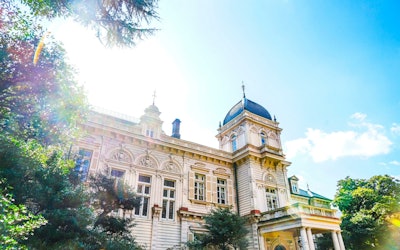Kyu-Iwasaki-tei Gardens: The Beautiful Building in Taito City, Tokyo That Left Its Mark on the Architectural History of Japan. This Is Where Japan's Modern Architectural Culture Began!
Art & Architecture
Travel
What is the "Former Iwasaki Residence Garden" in Taito-ku, Tokyo?
This video, titled "Kyu-Iwasaki-tei Gardens – Area Information|Video Website|Machi Log," introduces Kyu-Iwasaki-tei Gardens, a wooden, European-style building that was built more than 120 years ago in 1896 (year 29 of Meiji), for the founder of Mitsubishi, Hisaya Iwasaki.
Due to the dissolution of the zaibatsu, as directed by SCAP after the war, the Iwasaki Family residence was requisitioned and they lost much of the buildings and garden; however it was later returned to the Japanese government. Presently, there are 3 buildings left, the Western-style building (main building), the billiard room, and the Japanese-style building. They are designated as important cultural properties.
The building itself was designed by the Englishman, Josiah Conder. An authentic, wooden, Western-style 2 story building with a basement was very rare at the time and it is said to have eventually had a large influence on modern day Japanese housing.
All of the Kyu-Iwasaki-tei Gardens is open to the public as a metropolitan garden, and there is also a café there so it's teeming with people during lunchtime or seasons in which you can see the cherry blossoms and autumn foliage.
The elegant Western-style building is also used for filming many TV dramas and movies thanks to its beautiful appearance.
The Highlights of Kyu-Iwasaki-tei Gardens
Source :YouTube screenshot
There are so many points of interest at Kyu-Iwasaki-tei Gardens that we couldn't possibly cover them in one go.
The architecture of the semi-Western mansion representing the wealthy of the Meiji era (1868-1912) immediately after the opening of the country, is considered to be a very modern style even by present-day standards. When you enter the house, the decorations, including vines wrapping around the wooden columns, catch one's eyes immediately. This particular design is called Jacobian-style architecture and was very popular in 19th century England.
This can be seen from 1:10 in the video.
The wooden billiards room is designed in the style of a Swiss mountain hut, which was rare in Japan at that time. The Japanese-style building, which was used by Hisaya Iwasaki, was decorated with screen paintings by the great Japanese artist, Masakuni Hashimoto.
The billiards room can be seen at 1:58, and the Japanese-style building can be seen at 2:33 in the video.
Finally, the greatest highlight of Kyu-Iwasaki-tei Gardens is the rose garden that colors the entire lawn.
In autumn, the Autumn Festival is held, and the scent of its roses fill the entire Kyu-Iwasaki-tei Gardens, captivating the many visitors.
On the other hand, the serene Japanese-style garden has the look of a traditional Japanese garden, with garden stones, lanterns, and artificial miniature hills. At tea ceremonies, you can enjoy tea and Japanese confectioneries while enjoying the scenic nature of the seasons at the beautiful Kyu-Iwasaki-tei Gardens.
The Tumultuous History of Kyu-Iwasaki-tei Gardens
Source :YouTube screenshot
Kyu-Iwasaki-tei Gardens is located at Ikenohata 1-chome, Taito-ku, Tokyo, where the residence of the Takada Domain was located in the Edo period (1603-1868).
After the Meiji Restoration, due to the abolition of feudal domains and the establishment of prefectures in 1871, the Takada Domain was dissolved and it became the property of the former Maizuru clan governor, Sukeshige Makino. However, it was bought by Yataro Iwasaki who was part of a zaibatsu, and the 3rd generation head of that family, Hisaya Iwasaki, built Kyu-Iwasaki-tei.
After the war, the zaibatsu were dissolved by SCAP, the building became government controlled, and was managed by the Tokyo Metropolitan Government. It is indeed a monument that has survived a tumultuous history to the present day.
Summary of Kyu-Iwasaki-tei Gardens
Photo:Kyu-Iwasaki-tei Gardens
Kyu-Iwasaki-tei Gardens, the foundation of Japan's modern architecture, is currently undergoing restoration work on the lawn and is partly off-limits as of April 2020.
Tours are still taking place; however, so why not visit Kyu-Iwasaki-tei Gardens and get a taste of Japanese history?
Kyu-Iwasaki-tei Garden, a pillar of Japanese architectural history, is where Japan's modern architectural culture began.
◆Kyu-Iwasaki-tei Gardens|Facility Overview ◆
【Address】1-3-45 Ikenohata, Taito Ward, Tokyo 110-0008
【Access】A 3-minute walk from Yushima Station on the Tokyo Metro Chiyoda Line (~10-minute walk from Shinobazu lake)
walk from Shinobazu Pond)
【Admission Fee】General ¥400, Seniors over 65 ¥200, free for elementary school students and below and junior high school students who reside or attend school in Tokyo, and various discount rates such as group discounts
【Hours】9:00~16:30
【Closures】End of the Year, New Year’s Holiday
【Parking】Not available
【Telephone Number】03-3823-8340
【Official Website】Kyu-Iwasaki-tei Gardens|Let’s go to the park!
https://www.tokyo-park.or.jp/park/format/index035.html
【Tripadvisor】Kyu-Iwasaki-tei Gardens
https://www.tripadvisor.com/Attraction_Review-g1066461-d321036-Reviews-Kyu_Iwasakitei_Teien-Taito_Tokyo_Tokyo_Prefecture_Kanto.html
 Video article 3:55
Video article 3:55 Video article 4:57
Video article 4:57